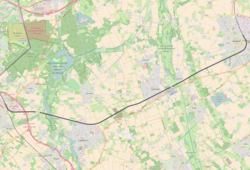Kempen – Venlo railway line
| Kempen – Venlo railway line | |||||||||||||||||||||||||||||||||||||||||||||||||||||||||||||||||||||||||||||||||||||||||||||
|---|---|---|---|---|---|---|---|---|---|---|---|---|---|---|---|---|---|---|---|---|---|---|---|---|---|---|---|---|---|---|---|---|---|---|---|---|---|---|---|---|---|---|---|---|---|---|---|---|---|---|---|---|---|---|---|---|---|---|---|---|---|---|---|---|---|---|---|---|---|---|---|---|---|---|---|---|---|---|---|---|---|---|---|---|---|---|---|---|---|---|---|---|---|
| Route number (DB) : | 2512 | ||||||||||||||||||||||||||||||||||||||||||||||||||||||||||||||||||||||||||||||||||||||||||||
| Course book section (DB) : | last 474 | ||||||||||||||||||||||||||||||||||||||||||||||||||||||||||||||||||||||||||||||||||||||||||||
| Gauge : | 1435 mm ( standard gauge ) | ||||||||||||||||||||||||||||||||||||||||||||||||||||||||||||||||||||||||||||||||||||||||||||
| State (D): | North Rhine-Westphalia | ||||||||||||||||||||||||||||||||||||||||||||||||||||||||||||||||||||||||||||||||||||||||||||
| Province (NL): | Limburg | ||||||||||||||||||||||||||||||||||||||||||||||||||||||||||||||||||||||||||||||||||||||||||||
| Operating points and routes | |||||||||||||||||||||||||||||||||||||||||||||||||||||||||||||||||||||||||||||||||||||||||||||
|
|||||||||||||||||||||||||||||||||||||||||||||||||||||||||||||||||||||||||||||||||||||||||||||
The Kempen-Venlo railway is a former railway line from the Lower Rhine Kempen in Germany to Venlo in the Netherlands . It was built by the Rheinische Eisenbahn-Gesellschaft and commissioned on December 23, 1867 for freight traffic and on January 1, 1868 for passenger traffic.
history
In the mid-1860s, three different avenues were up for debate. Variant A should be taken past the Krickenbeck lakes . According to variant B, a route was planned past the Grefrather Dorenburg in the direction of Hinsbeck and south-east along Leuth to Kaldenkirchen . The realized railway line corresponded to proposal C. There were also brief considerations about building a line from Lobberich via Boisheim to Waldniel . Waldniel was only later connected to the Dülken – Brüggen railway.
From Kaldenkirchen the line ran parallel to the Viersen – Venlo line of the Bergisch-Märkische Eisenbahn-Gesellschaft on the same route, so that both appeared together as a double-track line. Today the existing track on this section is assigned to the Viersen – Venlo line.
After the end of operations between Kempen and Grefrath, this section was converted into a cycle path and later the Grefrath – Kaldenkirchen section.
business
At first, trains pulled by locomotives drove here. When at the beginning of the 1960s more people were driving by car instead of by train, a Uerdingen rail bus (VT 95, also known as the savior of the branch lines ) drove on the route and finally a series 515 battery powered railcar . The tracks in Grefrath and Lobberich have largely been dismantled. The reception building in Lobberich was demolished in 1976, the train station in Grefrath is now home to a youth club and the train station in Mulhouse is now used for catering. After the cessation of passenger train traffic on the entire route on May 22, 1982 and the cessation of freight traffic between Kempen and Grefrath on May 28, 1983, there was still freight traffic on the remaining Grefrath – Kaldenkirchen section (shunting was also carried out in Lobberich), but it was closed At the beginning of the 1990s, it was severely restricted and completely discontinued on December 31, 1999.
Class 290 diesel locomotives mostly served two private connections on weekdays at the Lobberich freight yard and behind the Grefrath station . These activities ended on the railway line, which was once the main line and could keep up with the rival line Viersen – Venlo, with the final line closure on December 31, 1999. The last passenger train that ran the tracks between Lobberich and Kaldenkirchen was a special train that closed Film shooting began in 1991. Following closure of the millennium, the line was in Europe announced . At the beginning of 2004, although there were interested parties to take over the route, the rails on the old railway line were removed. Only the gravel and some track sections at the former level crossings on rural roads reminiscent of the former rail line. The passenger trains stopped at the stations Kaldenkirchen, Wittsee, Lobberich, Grefrath, Mülhausen- Oedt , Kamperlings and Kempen. The Mülhausen-Oedt stop was built in 1896 on the initiative of the monastery in Mulhouse . Today only the names of the bus stops remind of the old train stations in Lobberich and Mülhausen. The old station buildings, apart from the start and finish point of the route, only exist in Grefrath and Mülhausen.
On March 6, 1956, between Kempen and Mülhausen, a fully occupied rail bus driving to Kaldenkirchen collided with a truck at an open level crossing . The Kamperlings stop was created shortly after this incident.
literature
- Carl Fischer : Memories and Memories of a Worker . 1903. Peters took part in the construction of the route as a migrant / earthworker.
Web links
- Description of route 2512 in the NRWbahnarchiv by André Joost
Individual evidence
- ↑ Railway Atlas Germany 2007/2008 . 6th edition. Schweers + Wall, Aachen 2007, ISBN 978-3-89494-136-9 .
- ↑ Ludger Peters: Cycling without panting . In: Rheinische Post . December 9, 2008 ( rp-online.de [accessed on August 28, 2018]).
- ↑ Rheinische Post Sa ,. May 18, 2013, page C3 ("Blickpunkt Nettetal"); Article by Heinz Koch: "I was there when the railway was built"

